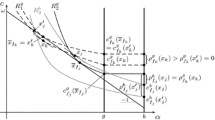Abstract
This paper studies the normative problem of redistribution between agents who can influence their survival probability through private health spending, but who differ in their attitude towards the risks involved in the lotteries of life to be chosen. For that purpose, a two-period model is developed, where agents’ preferences on lotteries of life can be represented by a mean and variance utility function allowing, unlike the expected utility form, some sensitivity to what Allais (Econometrica 21(4), 503–546, 1953) calls the ‘dispersion of psychological values’. It is shown that if agents ignore the impact of health spending on the return of their savings, the decentralization of the first-best utilitarian optimum requires intergroup lump sum transfers and group-specific positive taxes on health spending. Under asymmetric information, a differentiated taxation across agents is still required, but subsidizing health spending may be optimal as a way to solve the incentive problem.
Similar content being viewed by others
References
Allais, M. (1953). Le comportement de l’homme rationnel devant le risque: critique des postulats et axiomes de l’Ecole Americaine. Econometrica, 21(4), 503–546.
Becker, G., & Philipson, T. (1998). Old-age longevity and mortality contingent claims. The Journal of Political Economy, 106(3), 551–573.
Becker, G., Philipson, T., & Soares, R. (2005). The quantity and the quality of life and the evolution of world inequality. The American Economic Review, 95(1), 277–291.
Bell, D. (1985). Disappointment in decision making under uncertainty. Operational Research, 33, 1–27.
Bommier, A. (2006). Uncertain lifetime and intertemporal choice: risk aversion as a rationale for time discounting. International Economic Review, 47(4), 1223–1246.
Bommier, A., Leroux, M.-L., & Lozachmeur, J.-M. (2007). Uncertain lifetime, redistribution and nonlinear pricing of annuities (Working Paper).
Broome, J. (2004). Weighing lives. New York: Oxford University Press.
Hagen, O. (1979). Towards a positive theory of preferences under risk. In M. Allais & O. Hagen (Eds.), Expected utility hypotheses and the Allais paradox. Dordrecht: Reidel.
Halek, M., & Eisenhauer, J. (2001). Demography of risk aversion. Journal of Risk and Insurance, 68(1), 1–24.
Kaplan, G. A., Seeman, T. E., Cohen, R. D., Knudsen, L. P., & Guralnik, J. (1987). Mortality among the elderly in the Alameda county study: behavioral and demographic risk factors. American Journal of Public Health, 77(3), 307–312.
Leroux, M. L. (2008). Endogenous differential mortality, non monitored effort and optimal non linear taxation (CORE DP 29).
Loomes, G., & Sugden, R. (1987). Some implications of a more general form of regret theory. Journal of Economic Theory, 41(2), 270–287.
Machina, M. (1983). Generalized expected utility analysis and the nature of observed violations of the independence axiom. In B. Stigum & F. Wenstøp (Eds.), Foundations of utility and risk theory with applications. Dordrecht: Reidel.
Machina, M. (2007). Non-expected utility theory. In S. Durlauf & L. Blume (Eds.), The new palgrave dictionary of economics (2nd ed.). New York: Macmillan.
Mosteller, F., & Nogee, P. (1951). An experimental measurement of utility. Journal of Political Economy, 59(5), 371–404.
Múnera, H., & de Neufville, R. (1983). A decision analysis model when the substitution principle is not acceptable. In B. P. Stigum & F. Wenstop (Eds.), Foundations of utility and risk theory with applications. Dordrecht: Reidel.
OECD (2007). Eco-Santé OCDE 2007, available online at http://www.oecd.org/dataoecd/45/20/38980771.pdf.
Poikolainen, K., & Escola, J. (1986). The effect of health services on mortality decline in death rates from amenable to non-amenable causes in Finland, 1969–1981. The Lancet, 1(8474), 199–202.
Schmidt, U. (2004). Alternatives to expected utility: some formal theories. In S. Barbera, P. J. Hammond, & C. Seidl (Eds.), Handbook of utility theory, Vol II. Boston: Kluwer, Chap. 15.
Sheshinski, E. (2007). The economic theory of annuities. Princeton: Princeton University Press.
Solomon, C., & Manson, J. E. (1997). Obesity and mortality: a review of the epidemiological data. American Journal of Clinical Nutrition, 66(4), 1044–1050.
Starmer, C. (2000). Developments in Non-Expected utility theory: the hunt for a descriptive theory of choice under risk. Journal of Economic Literature, 38, 332–382.
Stigum, B. P., & Wenstop, F. (Eds.). (1983). Foundations of utility and risk theory with applications. Dordrecht: Reidel.
Author information
Authors and Affiliations
Corresponding author
Rights and permissions
About this article
Cite this article
Leroux, ML., Ponthiere, G. Optimal tax policy and expected longevity: a mean and variance utility approach. Int Tax Public Finance 16, 514–537 (2009). https://doi.org/10.1007/s10797-009-9106-3
Published:
Issue Date:
DOI: https://doi.org/10.1007/s10797-009-9106-3
Keywords
- Longevity
- Risk
- Lotteries of life
- Non-expected utility theory
- Moments of utility theory
- Disappointment
- Health spending



